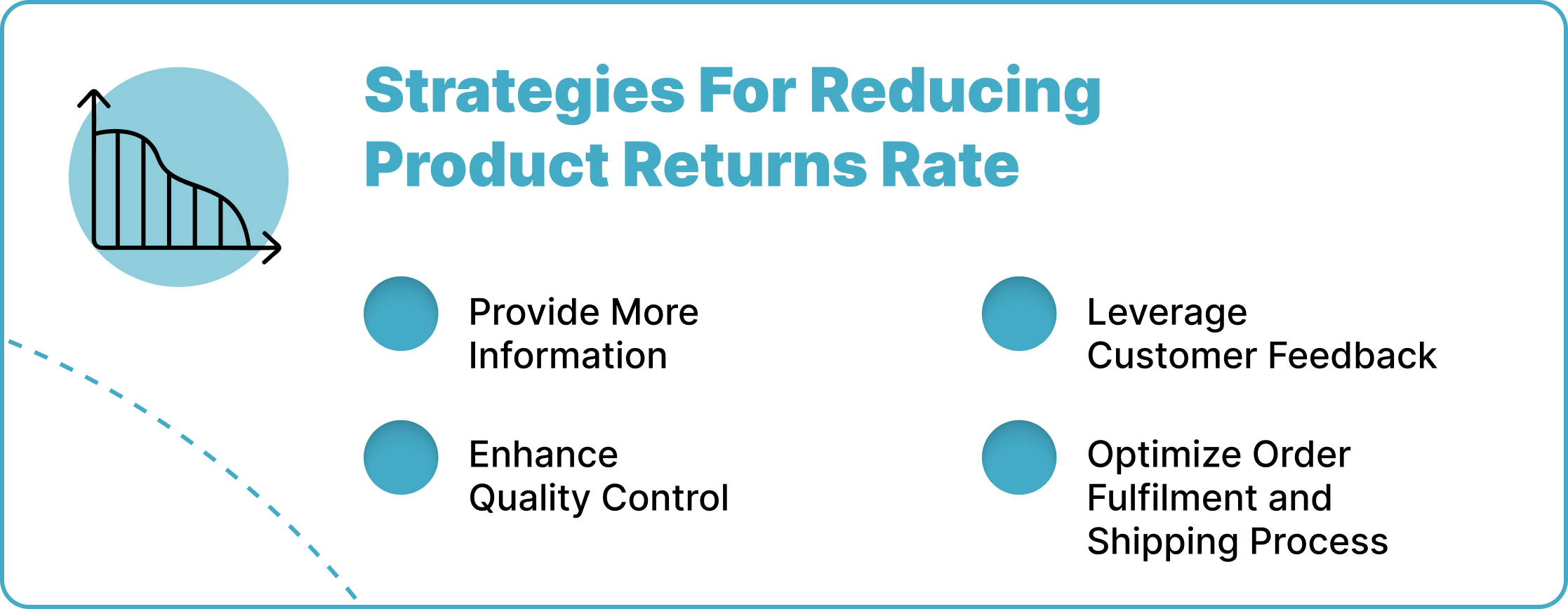Strategies For Reducing Product Return Rate

In the US, product returns account for a significant chunk of total retail sales today. According to the National Retail Federation, 17.6%, or $247 billion, of online retail products were returned in 2023. As a retailer, while you may never completely put a stop to product returns, does that mean you should be okay with high product return rates? The impact could be devastating to the bottom line and the allied reverse supply chain operations.
Having a clear return policy can help here. It is a lynchpin to assuaging customer concerns and managing product returns effectively.
If you are going to control and reduce the product return rates of your e-commerce business or online store(s), you might as well do it properly. This article outlines various strategies to help your supply chain reduce product return rates, leading to a better business experience for you and the customers.
Causes of High Product Return Rates
Understanding the reasons for high product return rates can help your business quickly identify trends and take steps to mitigate spiraling return rates. Fortunately, there aren’t many, making them easier to manage.
Here are some of the major causes:
1. Product Related Reasons
Even with all the supply chain and sales optimization, 23% of product returns are due to the wrong item being sent, but that’s not the only problem. Product defects are a significant cause of product returns. There are still issues with the quality of the product, as well as inaccurate or wrong descriptions of the product. In the fashion world, the issue of size still persists. All of these problems can be traced back to the business and result in a significant share of the product return reasons. It could also impact customer loyalty or, at the very least, customer lifetime value.
2. Customer Related Reasons
Many of the reasons customers return products are out of the control of the business or retail platform. Return fraud is a common issue, as are buyer remorse and wardrobing (when customers purchase multiple sizes and colors to keep just one). Then there are situations where gifts are returned by the receivers as they are unsuitable — a situation that crops up prominently in the aftermath of a peak buying season.
All of these are out of the retailer’s control, especially because of the nature of the challenge. Still, there are ways to manage this, such as offering opportunities to exchange the items with discounts or offering store credit rather than giving a full refund.
3. Operational Reasons
Operational failures, such as long lead times during the delivery process or poor packaging that leads to product damage, could turn off customers, leading to returns. Efficient return logistics can help mitigate operational failures. For example, a customer could order a product that takes three weeks to deliver due to a parcel forwarder mixup, or a customer who ordered a television could receive it broken. These operational failures could seriously impact customers’ choice to return said items.
Why it is Necessary To Reduce Product Return Rates
Allowing the product return rate to run amok can put a lot of pressure on the business, especially concerning finances and operations. Here are a few vital reasons to consider return rate reduction.
1. Financial Benefits
By reducing the return rates, the business can save on return costs, including logistics and transportation expenses involved in the reverse logistics process of collecting customer items and sending them back into the supply chain. It can also increase profit margins because some of these returns come back damaged and cannot be processed into the supply chain.
2. Operational Benefits
When there is less pressure from product returns, it will take less time and resources, allowing other more essential aspects of the supply chain to use these resources to optimize the entire process. Efficient return handling can free up resources for other essential aspects of the supply chain. Reducing product returns allows the business to identify areas for improvement in product quality, packaging, and logistics, resulting in a more efficient supply chain overall.
It also allows the return process to easily reabsorb the products into the supply chain and streamlines the process of tracking returned products.
3. Enhanced Customer Experience and Customer Satisfaction
Although customers want the ability to return purchased items in case of wrong deliveries or issues with the product, they do not necessarily like the idea of returning. Enhancing the return experience and reducing the probability of returns will significantly improve customer satisfaction. Some ways to accomplish this are by addressing product descriptions, improving packaging and quality of the products, offering pre-orders on products, and having a robust order fulfillment system that eliminates delivery mistakes.
Strategies For Reducing Product Returns Rate

Return prevention benefits any business, including the average brick-and-mortar store. However, doing so will entail various strategies, and each will depend on how the business is optimized.
Here are some of the strategies:
1. Provide More Information
Information is powerful for customers as it allows them to understand each product and how it impacts their lives. Return policy clarity is crucial in reducing return rates. For example, product descriptions, including sizes, and guides on what these products do for the customer. Always remember that because of the nature of the e-commerce platform, there is limited visibility on the part of the consumer.
Adequate information gives customers a robust picture of each product and what to expect. This reduces attrition, and customers will not purchase a product with the wrong expectations. Part of providing information to the customers is through a robust and user-friendly returns policy that details the business’s returns process, including acceptable returns and the refund process. It ensures there are no misunderstandings with the returns experience.
2. Enhance Quality Control
This is one of the most expensive returns because it cannot be resold to other customers, which means a total loss for the business. To achieve better quality assurance and quality control, the business may implement stringent quality control measures to minimize the chances of defective or damaged products reaching customers and conduct thorough inspections before shipping to ensure product integrity.
3. Leverage Customer Feedback
Customers are the main attraction to the business and supply chain; therefore, it makes sense to tailor the entire operation to satisfy them by leveraging customer insights. One of the key ways to do that is through leveraging technology solutions like ReverseLogix RMS to seamlessly collect and analyze their reactions to different processes, how they feel about certain features, and areas where they believe the platform can improve. Leveraging customer feedback kills two birds with one stone. It enhances the overall customer experience and reduces the business’s product return rate.
4. Optimize Order Fulfilment, Shipping, and Returns Management Process
No matter how optimized the platform is, it may all be for naught without doing the same to the order fulfillment and shipping process. Shipping accuracy is crucial in reducing return rates. That is why optimizing both processes is key to reducing product return rates. Doing this entails leveraging and integrating technology solutions such as WMS, TMS, and any inventory management software into platforms like ReverseLogix RMS. This way, both processes are much more streamlined and automated to a great degree, and they increase the throughput of the process.
Reducing Product Return Rate With ReverseLogix
Reducing the product return rate requires a robust return management system. This is why you need ReverseLogix. Features like automation, analytics and tracking, integration, and repair management on ReverseLogix allow your business to streamline and help optimize your entire returns management process and supply chain, leading to lower return rates. Get a demo with us today.
Frequently Asked Questions
Yes. Try including detailed size charts and consider tools like virtual try-ons or fit predictors. You could also showcase how the product fits different body types in your images.
Absolutely! To prevent returns, focus on improving product quality and providing accurate descriptions. When returns happen, efficient processing and potential product refurbishment can help recoup some costs.
Consider your return policy. If it’s too lenient, it might impact customer expectations negatively and encourage unnecessary returns. You could also look at how you package your products to minimize damage during shipping.
Yes! A returns management software can help you streamline the process of managing returns. Beyond that, it gives you insights into why customer returns are happening and can help you predict which items might be returned more often. With tech solutions like RMS, you can reduce return rates and manage returns seamlessly.
